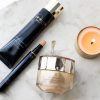
It’s important to know about the health of your breasts, and monthly self-checks allow you to understand how your breasts look and feel so you’re able to report anything out of the norm to your doctor.
According to Johns Hopkins Medicine, four in 10 cases of breast cancer are first detected by women during a self-exam. When used in combination with annual mammograms, regular appointments, and healthy lifestyle practices, a self-exam is an impactful screening tool that is convenient and free.
Breast cancer that is caught early is more likely to be successfully treated, so follow the guidelines below on how to effectively conduct a breast self-exam.
Look at your breasts in the mirror
With your hands on your hips, shoulders back, and chest up, take notice of the size, shape, and color of your breasts. Are your breasts evenly shaped? Are there any distortions or swelling? Some warning signs to look for are dimpling, swelling, change in size, a nipple turned inward or outward, and skin that has become scaly or red.
Raise your arms over your head
Look for any fluid coming out of either breast. This could be yellow, clear, or bloody. Milky discharge that is present when a woman is not breastfeeding should be checked by a doctor as well.
Examine your breasts using your hand
While it may feel strange at first, the shower is a great place for this since your skin is wet and slippery. Keeping your fingers flat and together, begin moving them in a circular motion. You will continue this front to back, side to side, and from your collarbone to your tissue. Use light pressure for the skin just behind your nipple and firm pressure for deep tissue. Signs to look for are a lump in the breast, nipple tenderness, abnormal skin texture, or thickening tissue in or near the breast or underarm.
Perform the exam again lying down
Perform the same test lying on your back using your right hand to check your left breast and your left hand to check your right breast. This way, you’ll get a feel of your breast in a different position and be able to more thoroughly check for signs. The more awareness you have about how your breasts feel, the better you are able to detect warning signs.
Conduct breast self-checks monthly
A woman’s body goes through cycles each month as hormones fluctuate, and these changes may affect the look and feel of your breasts. It’s important to conduct self-exams at the same time each month so that you’re able to identify any abnormal changes. It’s best to conduct self-exams at the end of your cycle each month as this is the time when your breasts are the least tender and affected by changing hormones.
Of course, you should always consult with your physician about any questions or concerns.
xx, The FabFitFun Team




